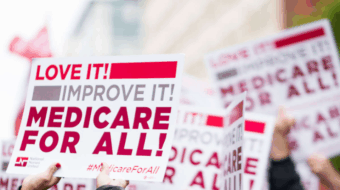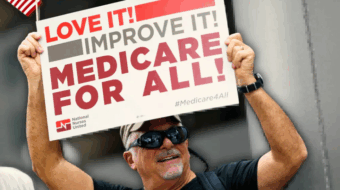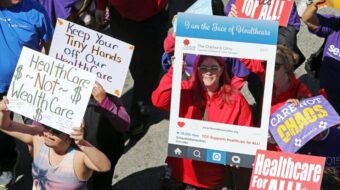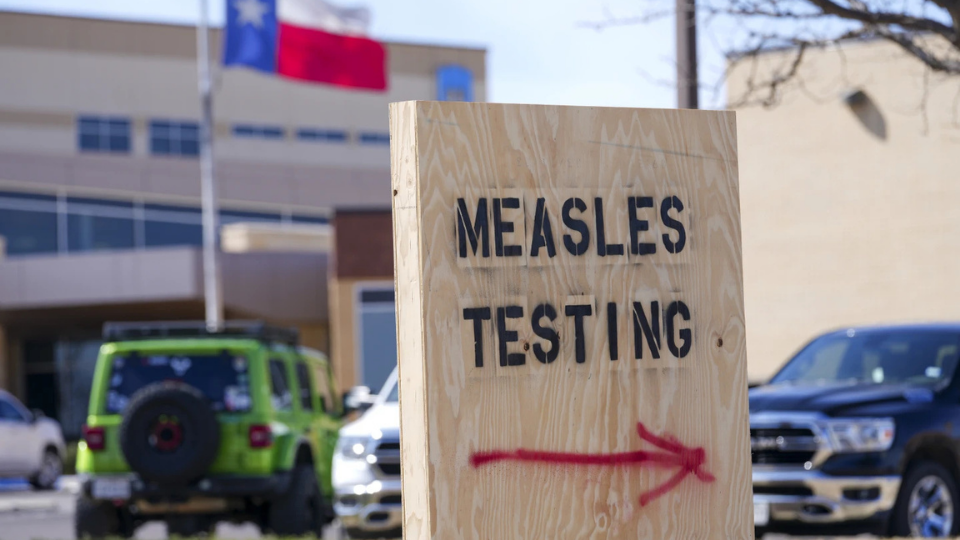
WASHINGTON—The number of measles cases in the U.S. has now surpassed the numbers in any year since 2001, the year the extremely contagious disease was officially declared eliminated. The findings, in a chilling report just released by the Centers for Disease Control, are actually an early sign that, due to right-wing politics, the nation’s entire public health system is on the verge of collapse.
They are also a clear indication that if there is not a massive increase in nationwide vaccination efforts, people getting sick and even dying from measles will be the new normal in the United States and, even worse, new epidemics of other diseases could soon follow.
That latter scenario of additional new epidemics is likely even if the measles scourge does not, by itself, become a pandemic like the coronavirus, which killed more than one million and resulted in 21 million cases of long COVID, often lasting a lifetime.
Miners often carried caged canaries into the mines with them. When the canaries fell dead off their perches, they knew it was time for them to clear out of the mine shafts before the coal gas got strong enough to kill them. Epidemiologists have often said that measles epidemics serve public health in a similar way. Once there is a measles epidemic, they note, it’s only a short time before numerous other viruses move in to sicken the public.
In the early 1950s, many children in the U.S. were infected with measles, and their families learned that the hard way. Doctors who made home visits in those days wanted to get the plague over with quickly, so, in a multi-child family, they advised that the children be put into the same bed so the family could get over the measles infection. Once they got over the measles, however, many children then often came down with mumps, chicken pox, flu viruses, meningitis, and numerous other illnesses. That is because, as we now know, measles causes immune amnesia, a condition which makes the body forget the immune responses it has built up to a number of other diseases.
The measles epidemic is also endangering the “elimination status” of the U.S., a status granted to countries that have achieved a halt in the spread of measles for more than one year. The fear there is that the country or parts of it could end up on lists of places people around the world are warned not to visit.
Most of the cases have happened in the Southwest, beginning first in a Mennonite community in Texas and then spreading first in Western Texas and then infecting many across state borders in New Mexico and Oklahoma. No one in the country can breathe easily, however, because cases have also been detected in 38 other states.
The total number of confirmed cases this year is 1,288. At least 92 percent of them are unvaccinated, with the vaccination status of most of the rest of them unknown.
Although many recover from fever, coughs, and rashes in a few weeks, some have gotten pneumonia, which makes it difficult, especially for children, to breathe. Brain swelling, blindness, and deafness can also result from measles infection in some cases. The CDC says 2 of every 1,000 children infected will die. Two unvaccinated adults and one child are confirmed dead already, the first to die of measles in ten years, according to the CDC.
Loss of elimination status is expected soon, with officials in West Texas saying the epidemic there is likely to continue for another year. That adds to the almost certain assessment by many health experts that there are many results of the measles epidemic that will not be known for a long period of time. Aggressive vaccination efforts must be launched if there is hope of curbing both immediate and long-term effects of the disease, most of them say. They also note that to be effective, the vaccination rates in an area must approach 95%. Lower rates will allow the disease to pop up even in areas where many are vaccinated.
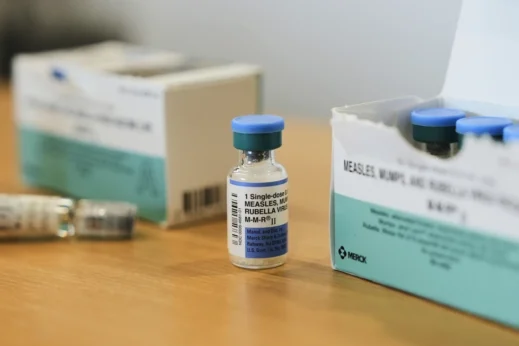
In Gaines County, Texas, where the current epidemic started, the vaccination rate is only 82%. It is clear that right-wing anti-vax propaganda, then, is a major factor in the growing epidemic.
Unfortunately, like what happened with the coronavirus in the first Trump administration, the U.S. as a whole and certain states in particular—with Texas in the lead—apparently are ill-equipped to deal with it.
The right wing continues to make it more difficult. Online, for example, some are ranting about immigrants bringing in the virus because, they say, the immigrants come from places with no vaccine mandates. Yet it is their right-wing compatriots here who have fought against vaccine mandates.
A major obstacle then is the aforementioned increasing skepticism about vaccines, perpetrated by conspiracy theorists and the radical right. Another is Donald Trump’s Health and Human Services Secretary, Robert F. Kennedy Jr. The recent passage of Trump’s so-called Big Beautiful Bill is both an immediate and long-term obstacle to combating epidemics and pandemics because it shreds the nation’s public health system. Any realistic plan to combat the health dangers the nation faces would have to include the repeal and replacement of that killer bill. Part of the new bill should be Medicare for All.
Measles was declared eradicated in the U.S. in 2000 after decades of a mass program of early vaccination, especially of kids aged five and under. Most school districts now require almost all children entering kindergarten to be inoculated with the measles, mumps, and rubella (MMR) vaccine.
There are limited exemptions, especially for “religious” reasons, but all but a handful of states still have 90% or more of their children vaccinated. “Community immunity,” often called “herd immunity,” to any disease, is achieved when 95% of the impacted population is vaccinated.
Measles immunity dropped
But measles immunity among the nation’s 3.8 million kindergarteners has dropped, the federal Centers for Disease Control reports, from 95.2% during the 2019-20 school year to 92.7% in the 2023-24 school year. That left approximately 280,000 kindergartners at risk of measles that year. And they’re the most vulnerable group, with the longest impacts from the disease.
Measles is such a threat because it is so easily transmissible. Think “the coronavirus,” only worse.
“Measles is highly contagious. If one person has it, up to nine out of 10 people nearby will become infected if they are not protected,” the federal Centers for Disease Control warns. “The best protection against measles is the measles, mumps, and rubella vaccine. It provides long-lasting protection against all strains of measles.”
One reason measles is so hard to defend against is that it takes a week or two before symptoms—high fever, coughing, runny nose, pink eye, and especially rashes and spots—appear, the CDC says.
The CDC reports that those kids, aged five and under, account for 360 (28%) of the measles cases so far this year. Older kids and teens, aged 5-19, account for another 464 cases (37%).
Untreated, especially in younger children, measles complications can include diarrhea, ear infections, and in serious cases, encephalitis and pneumonia. One of every eight measles victims this year, of all age groups combined, had to be hospitalized. CDC reports 92% of the hospitalized were unvaccinated.
That last number points up the first problem public health officials face in combating this latest epidemic: Vaccine skepticism.
“In a 2024 survey of U.S. parents, 8.3% disagreed with the statement that school and child care ‘vaccination requirements for children are important and necessary,’ similar to the percentage of children not fully vaccinated,” the Centers for Disease Control reported. “Another 15.2% of parents had no opinion.
“At local levels, vaccine coverage rates may vary considerably, and pockets of unvaccinated people can exist in states with high coverage,” the CDC adds. That brings the focus to Texas and to Idaho.
More than half—at least 700—of all reported U.S. measles cases so far this year occurred in Texas. So did two of the three known measles deaths. Yet 92% of endangered Texans are vaccinated.
Next on the list: Kansas and New Mexico
Next on the list are Kansas and New Mexico, with 50-99 reported cases each. Every other state, including California, reported fewer than 49 measles cases. New York City reported fewer than nine. So did Florida. D.C. had none.
Texas has an “exemption” problem, too. School districts nationwide granted exemptions from vaccination for 126,767 kids in the 2023-24 school year. More than one of every nine was a Texan (14,727). Colorado was second, with 11,031. And three states—Missouri, Colorado, and Minnesota—reported parents sought exemptions covering more than one of every four kindergarteners.
In all but a handful of states, more than 90% of people are vaccinated, including those vaccinated twice. “Community immunity” to an infectious disease, also called “herd immunity,” is achieved with 95% coverage. Three states had coverage in the 80%-90% range, just behind Texas’s 92%.
Idaho was dead last, at 79.8%, the CDC reported. It was also dead last in coverage for all other vaccines, such as for diphtheria, with similar figures.
The CDC did not speculate about why so many Idahoans are unvaccinated. But Idaho has a disproportionate share of extreme nationalist, anti-government, and white supremacist groups, relative to its population, says the Southern Poverty Law Center, the most-reliable tracker of hate groups.
Members of those groups hate and/or distrust mandates about vaccines.
Which brings us to RFK Jr., the well-known anti-vaxxer who is now Donald Trump’s Secretary of Health and Human Services. Under pressure from Sen. Maggie Hassan, D-N.H., during his confirmation hearing for the HHS post earlier this year, Kennedy grudgingly admitted that vaccination is important for preventing pandemics.
But Kennedy’s actions since he took the top HHS post belie his statement to Hassan. He fired the entire Advisory Committee on Immunization Practices. That 17-member panel advises the CDC about vaccines and their success, or lack thereof. Its recommendations often determine whether insurers will cover specific vaccines. Kennedy’s new panel includes at least two vaccine skeptics.
The advisory committee, which was made up of what were independent experts, “plays a critical role in evaluating the safety, effectiveness, and public health need for vaccines,” says the National Consumers League.
“Its recommendations guide immunization practices for children, seniors, and the general public—including routine vaccines such as the annual flu shot.
Not a conflict of interest
“Expertise is not a conflict of interest—it’s a safeguard,” said NCL CEO Sally Greenberg. “ACIP members are among the most respected scientists and physicians in the country. To remove them wholesale is reckless, and to do so without a clear plan for who will replace them…puts the health of every American at risk.”
“ACIP plays a critical role in determining the safety, efficacy, and recommended use of vaccines–decisions that directly impact whether lifesaving immunizations are covered by public and private insurance. Removing the entire committee without naming qualified replacements risks delaying these essential decisions, weakening public trust, and politicizing what must remain an evidence-based process,” NCL says.
Kennedy went one step further by releasing his “Make America Healthy Report” on June 2 and seeking more federal money to implement its recommendations.
“This report is a diagnosis without a treatment plan. It’s a muddled mix of cherry-picked, outdated, and misleading data designed to stoke fear, not solve problems,” NCL’s Greenberg explained. “It reads less like a roadmap for public health and more like a conspiracy manifesto in a lab coat.”
The league added that “on issues NCL has long championed–vaccines, food safety, and nutrition labeling–the report is troubling. It casts baseless doubt on vaccine safety, questions food regulations grounded in science, and floats vague, unworkable notions that would unravel decades of hard-won consumer protections.”
The Consumers League isn’t the only organization upset by Kennedy’s anti-vaxx crusade. A 17-group coalition, the Health Equity Collaborative, raised the same concerns—and more—in a letter to congressional leaders of both parties. The Consumers League, a signer, posted an article about it.
The group demands that Congress force Kennedy to “restore scientific integrity to the advisory committee by reversing the removal of independent experts and ensuring future appointments reflect evidence-based standards.” It also seeks a law to “safeguard the committee from political interference.”
And the Health Equity Collaborative advocates “counteracting vaccine misinformation by allocating resources to public education campaigns focused on historically marginalized communities,” namely, communities of color: Blacks, Latinos, and Indigenous Peoples. Signers included reps of those groups.
“The recent dismantling and politically motivated restructuring of the ACIP committee is a profound disservice to public health, especially for our communities who already face significant barriers to equitable healthcare access and often rely on clear, trusted guidance,” said Amy Hinojosa, President and CEO of MANA, a national Latina organization and co-founder of the collaborative.
“To replace seasoned scientific experts with individuals who amplify misinformation undermines the very foundation of evidence-based medicine and will sow dangerous seeds of mistrust. Our families deserve science, not ideology, when it comes to protecting their health and the health of our children.”
Even the American Medical Association, not often known for being groundbreaking, got upset. At its latest convention, in early June, it adopted a special resolution blasting Kennedy’s actions, demanding he reverse course and calling for a Senate investigation of them.
The AMA also pledged to find alternatives for scientists and specialists to ensure vaccines—including measles vaccines—are safe and effective, and allotted $2.5 million from its budget for that initiative.
We hope you appreciated this article. At People’s World, we believe news and information should be free and accessible to all, but we need your help. Our journalism is free of corporate influence and paywalls because we are totally reader-supported. Only you, our readers and supporters, make this possible. If you enjoy reading People’s World and the stories we bring you, please support our work by donating or becoming a monthly sustainer today. Thank you!




